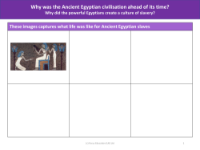Ancient Egypt and slavery - Writing task

History Resource Description
The rulers of Ancient Egypt relied heavily on their slaves to construct the monumental structures that have come to symbolize their civilization, such as the majestic pyramids, temples, and tombs. Slavery provided the vast workforce needed for these labor-intensive projects, which required not only sheer manpower but also a hierarchical system to manage such a large number of workers efficiently. Slaves were integral to the building process, carrying out tasks ranging from manual labor, like hauling massive stone blocks, to more skilled work, including carving and painting. The reliance on slaves allowed Egyptian rulers to channel resources and human power into these grand architectural feats, demonstrating their wealth, power, and religious devotion to both their people and the gods they worshipped.
Ancient Egypt was considered ahead of its time due to its remarkable advancements in various fields, including architecture, engineering, medicine, and agriculture. The civilization's ability to organize and execute large-scale construction projects, develop sophisticated irrigation systems, and cultivate an understanding of medicine and surgery set it apart from contemporaries. Moreover, the development of a writing system, hieroglyphics, facilitated record-keeping and communication, further advancing their society. The creation of a culture of slavery in Ancient Egypt was, in part, a consequence of the society's stratification and the rulers' desire to maintain and demonstrate their power. By institutionalizing slavery, they could ensure a steady supply of labor for their ambitious projects and maintain the social order that kept them at the pinnacle of power and influence.




